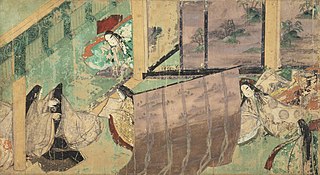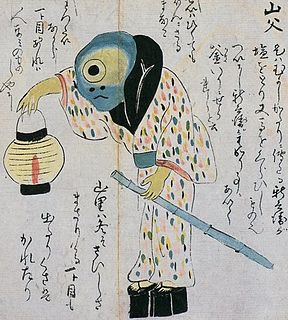 W
WEmakimono or emaki (絵巻) are Japanese illustrated handscrolls that have been produced since the 10th century. Emakimono combine both text and image in telling a narrative. They can be "an almost cinematic experience as the viewer scrolls through a narrative from right to left, rolling out one segment with his left land as he re-rolls the right hand portion." They depict a variety of stories including battles, romance, religion, folk tales, and stories of the supernatural world. They are intended to provide cultural information and teach moral values.
 W
WThe Buson yōkai emaki (蕪村妖怪絵巻) is an 18th century collection of "picture scrolls" depicting Japanese yōkai by poet and painter Yosa Buson. The whereabouts of the original work are presently unclear; its contents are known from a reprinting released by the Kitada Shisui Collection in 1928.
 W
WFukinuki yatai (吹抜屋台) describes a feature of Japanese art particularly associated with e-maki (絵巻) painted scrolls, famously for example, yamato-e.
 W
WThe Genji Monogatari Emaki (源氏物語絵巻), also called The Tale of Genji Scroll, is a famous illustrated hand scroll of the Japanese literature classic The Tale of Genji is from the 12th century, perhaps c. 1120–1140. The surviving sections, now broken up and mounted for conservation reasons, represent only a small portion of the original work and are now divided between two museums in Japan, Tokugawa Art Museum and the Gotoh Museum, where they are only briefly exhibited, again for conservation reasons. Both groups are National Treasures of Japan. It is the earliest text of the work and the earliest surviving work in the Yamato-e tradition of narrative illustrated scrolls, which has continued to impact Japanese art, arguably up to the present day. The painted images in the scroll show a tradition and distinctive conventions that are already well developed, and may well have been several centuries in the making.
 W
WThe Murasaki Shikibu Diary Emaki is a mid-13th century emaki, a Japanese picture scroll, inspired by the private diary (nikki) of Murasaki Shikibu, lady-in-waiting at the 10th/11th centuries Heian court and author of The Tale of Genji. This emaki belongs to the classical style of Japanese painting known as yamato-e and revives the iconography of the Heian period.
 W
WThe Sumiyoshi Monogatari Emaki (住吉物語絵巻) is an emakimono from the Kamakura period of Japanese history (1185–1333). It illustrates the Sumiyoshi Monogatari, a 10th century novel that narrates the misadventures of a young girl mistreated by her stepmother and her romance with a high-ranking soldier. The work is classified as Important Cultural Property and is preserved at the Tokyo National Museum, but four fragments became detached during the 19th century.
 W
WThe Tosa Obake Zōshi is a Japanese yōkai emaki. Set in the Tosa Province, and 16 sections about yōkai in total, its creation period has been determined to be from the Edo period. Its author is unknown. There are two kinds, the private collection, and the collection of the Sakawa Education Committee of Sakawa, Kōchi Prefecture.